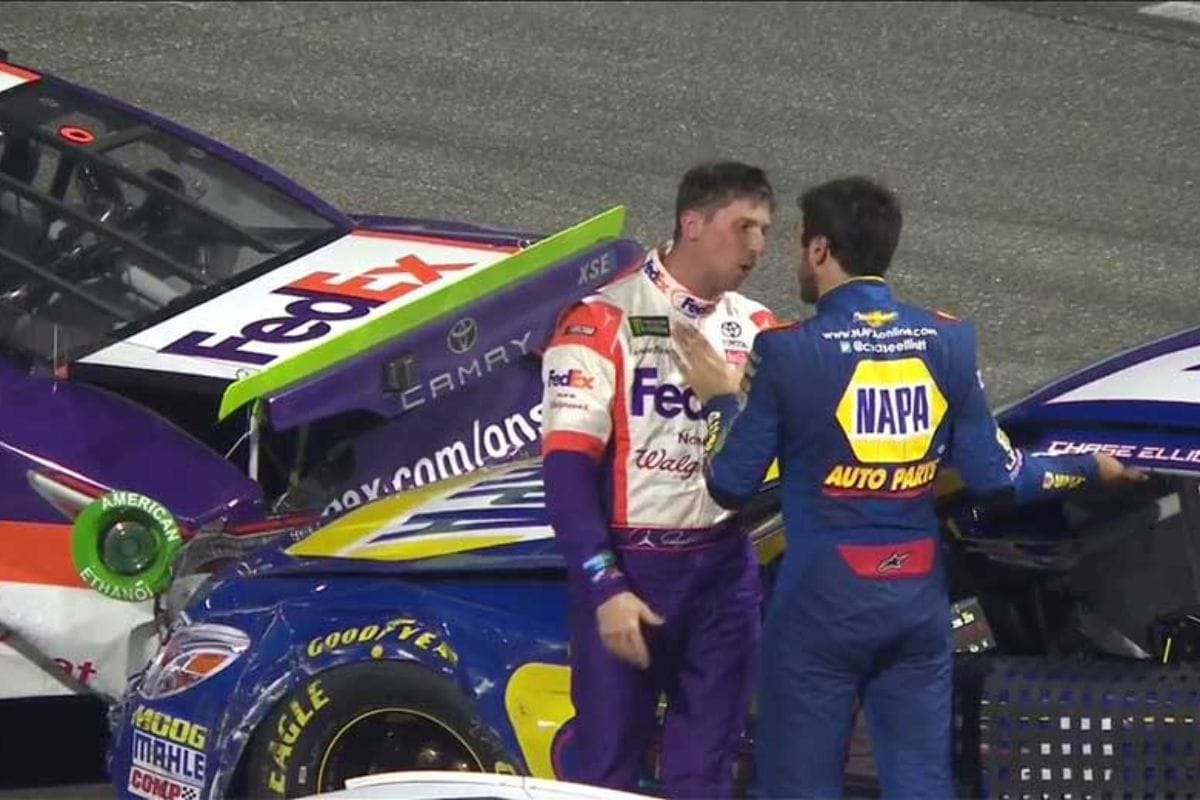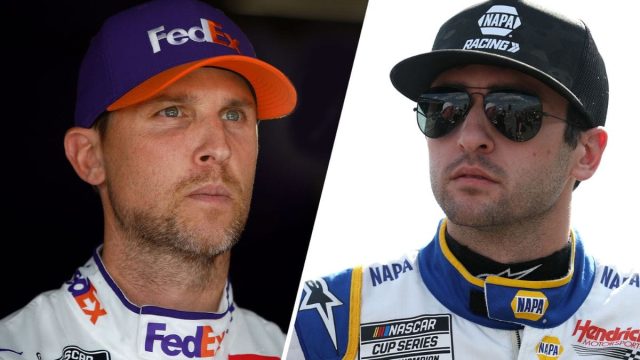NASCAR Revisits 2017 Hamlin-Elliott Feud: The recent resurgence of discussions surrounding the 2017 feud between Denny Hamlin and Chase Elliott highlights the enduring complexities within NASCAR’s fan dynamics. This rivalry, characterized by Hamlin’s controversial on-track maneuver that cast him as a ‘villain’ and Elliott as a ‘hero,’ not only polarized fans but also illuminated broader themes of competitive integrity and ambition in motorsport. As supporters passionately defend their preferred driver, the implications of this incident continue to echo in the sport, raising questions about the nature of rivalry and its role in shaping narratives. What does this mean for the future interactions on the track?
Key Highlights
- The 2017 incident between Hamlin and Elliott ignited a long-standing feud, marked by a controversial bump that caused a significant crash.
- Hamlin’s actions during the race positioned him as a ‘villain’ among many fans, while Elliott gained the support of a devoted fanbase.
- Fan reactions to the feud continue to polarize, with many criticizing Hamlin’s competitive integrity and defending Elliott’s championship credentials.
- Social media plays a critical role in amplifying the emotional intensity of the rivalry, with discussions reflecting the evolving narrative of heroes and villains in NASCAR.
Background of the Feud
The feud between Denny Hamlin and Chase Elliott traces its origins to a pivotal moment in the 2017 NASCAR season, where a controversial on-track maneuver ignited a rivalry that would captivate fans and analysts alike.
As the season progressed, the competitive landscape of NASCAR became increasingly intense, with both drivers representing esteemed teams—Hamlin with Joe Gibbs Racing and Elliott with Hendrick Motorsports. Their contrasting racing styles and fanbases only fueled the tension, setting the stage for a memorable encounter.
In the October 2017 race, the stakes were high, and both drivers were vying for supremacy. Elliott, already a fan favorite, was keen to secure his place at the front, while Hamlin sought to reclaim his standing in the playoff contention.
The dynamic of their positions on the track became pivotal; Elliott, starting in the third position, was positioned to capitalize on opportunities, while Hamlin’s struggle to maintain pace highlighted his vulnerabilities.
This background of rivalry was marked not only by competition but also by the inherent pressure of performance within NASCAR’s elite tier. The implications of their on-track interactions extended beyond mere points; they represented the broader narrative of ambition, strategy, and the unrelenting quest for victory.

The Controversial Maneuver
A pivotal moment in the Hamlin-Elliott rivalry occurred during the October 2017 race when Hamlin executed a controversial maneuver that would remarkably alter the dynamics of their relationship and the perceptions of fans. As the race neared its finale, Hamlin closed in on Elliott, ultimately bumping into Elliott’s rear, which sent him crashing into the wall. This decisive action not only shifted the race into overtime but also ignited a fierce confrontation on pit road, where Elliott visibly expressed his discontent.
This incident is notable for several reasons:
- Catalyst for Rivalry: The maneuver marked the beginning of a long-standing feud, establishing Hamlin as a figure of controversy and inciting strong emotions among fans and fellow drivers alike.
- Impact on Reputation: Hamlin’s actions framed him as a ‘villain’ in the eyes of a substantial portion of the NASCAR audience, influencing how he would be perceived in subsequent races. This shift in narrative would follow him for years.
- Fan Engagement: The resurfacing of this moment on social media platforms has reignited discussions among fans, showcasing how pivotal events continue to shape the narrative within the NASCAR community and foster ongoing engagement.
Fan Reactions and Comments
Fan reactions to the ongoing Hamlin-Elliott feud reveal a complex tapestry of emotions, showcasing the polarized opinions that define contemporary NASCAR culture. The comments reflect a deep-seated loyalty among fans, particularly those supporting Chase Elliott, who take pride in his championship achievements over Denny Hamlin. This allegiance is palpable, with one fan asserting, “And Elliott still won a championship before Hamlin,” underscoring the importance of historical context in their rivalry.
That's @MartinsvilleSwy. #NASCARPlayoffs pic.twitter.com/5bZaik8wKz
— NASCAR (@NASCAR) August 3, 2024
Conversely, the criticisms directed at Hamlin highlight a sense of disillusionment regarding competitive integrity. One fan provocatively questioned, “If Hamlin was so much faster why not just pass on the outside?” This sentiment resonates with a broader concern among NASCAR enthusiasts regarding the standards of racing conduct, particularly in view of the Next Gen cars, which some fans believe have altered the spirit of competition at traditional tracks like Martinsville.
“I remember when Martinsville used to be great. Then came the next Gen 💔😩.” – fans’ reaction
Ultimately, the fervent discussions encapsulate an evolving NASCAR narrative where the lines between heroes and villains are continuously drawn, creating an electric atmosphere that fuels the sport’s enduring popularity.
Post-Race Reactions and Ongoing Tensions
Emotions ran high in the aftermath of the race, as Chase Elliott’s pointed remarks emphasized the deepening rift between him and Denny Hamlin, revealing that the feud is far from resolution.
In a tense post-race interview, Elliott expressed visible frustration, specifically critiquing Hamlin’s claims about being pushed. His assertion that “there were two car lengths between him and the next guy” highlights a growing skepticism about Hamlin’s narrative. Elliott’s mother’s adage, “If you don’t have anything nice to say, don’t say anything at all,” denotes his intent to disengage from further dialogue, yet the underlying tensions remain palpable.
“Funny thing was, he said somebody was pushing him, but there were two car lengths between him and the next guy. My mom always said ‘You don’t have anything nice to say, don’t say anything at all,’ so he’s not even worth my time. We’re gonna go on to Texas.” – Elliott
As the championship finale approaches, the ongoing animosity is likely to exacerbate the competitive atmosphere. The stakes are high, and both drivers are acutely aware that a single misstep could have considerable implications for their standings.
Key factors to reflect on include:
- Motivations: Both drivers are vying for a coveted spot in the championship, heightening the urgency of their rivalry.
- Public Perception: Fans and analysts are closely monitoring their interactions, often framing Hamlin as the ‘villain’ and Elliott as the ‘hero’ in this narrative.
- Future Confrontations: With races like Texas on the horizon, the potential for confrontations is heightened, as unresolved tension often translates into on-track aggression.
News in Brief: NASCAR Revisits 2017 Hamlin-Elliott Feud
The Hamlin-Elliott feud exemplifies the intricate interplay between competitiveness and sportsmanship within NASCAR.
The contrasting perceptions of Hamlin as a ‘villain’ and Elliott as a ‘hero’ reveal the deep-seated emotions that accompany such rivalries.
As fans continue to engage in passionate debates, the enduring nature of this conflict emphasizes the pivotal role that personal narratives and on-track incidents play in shaping the identities of drivers and their relationships with the fanbase.
ALSO READ: Corey LaJoie’s 2025 NASCAR Cup Series Future: Linked to Two Top Teams
